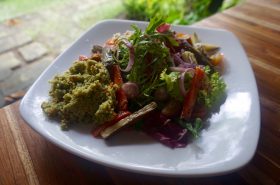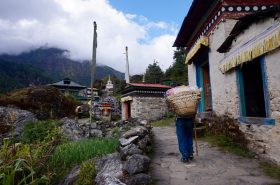1. The Mountains and Hiking
Over 70% of South Korea is mountainous, so it is no surprise that Koreans love to go hiking. It may not be what you are used to (it certainly wasn’t for me coming from Canada) but it still gives you a chance to enjoy Korea’s landscape and the outdoors. Koreans love to gear up for hiking in the latest high tech clothing and return from a day of hiking looking just as clean and unscathed as when they started (there are even air machines that blow all of the dust from your clothing at the base of most mountains). Visors, hiking boots, trekking pants, sweat resistant tops, blasting radios, and hiking poles are the items an average hiker in Korea comes prepared with. Don’t be intimidated by this! It is fine to go in comfortable sneakers and clothing, but be forewarned that you might be comparing yourself to the fancy Korean hikers along the trails every time you approach a mirror randomly on the mountain.
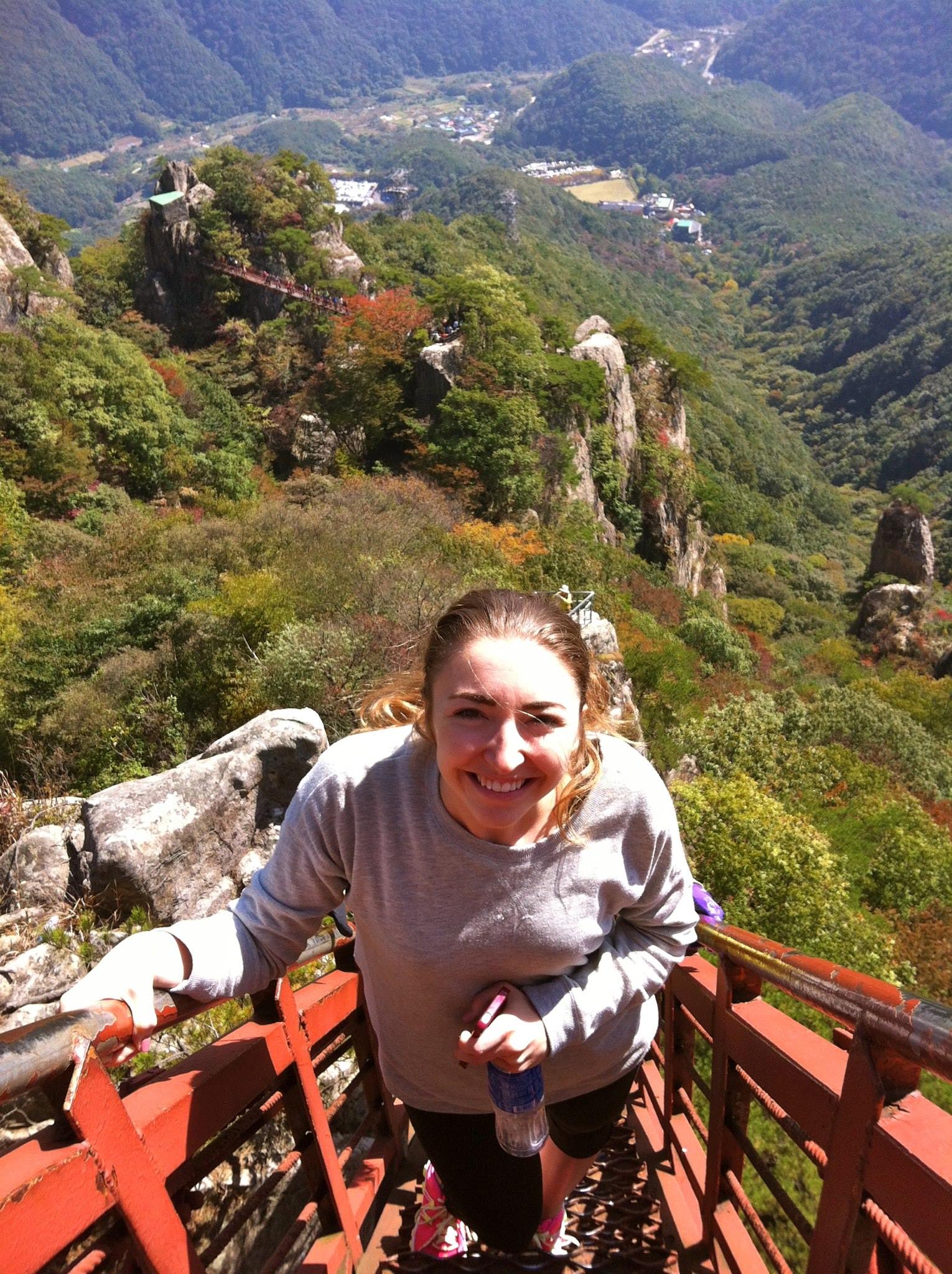
2. The Autumn Colors
Autumn is by far the best season in Korea. The temperature is perfect and the colors that emerge are breathtaking. Oranges, yellows, reds, browns, greens, purples, and other colors emerge with the cooling of the season. I find it best to truly appreciate the vast array of colors out on a mountain, but you will still be able to enjoy what fall has to offer within the cities.

3. The Kids
Now don’t get me wrong, kids…ALL kids are adorable; however, there is something extra cute about Korean children. They are absolutely beautiful, and I still squeal every time a little tyke waddles by me. Of course, it is not just about how they look, I have also noticed that Korean children are very calm and well-mannered in comparison to children I am used to seeing at home. Rarely do I see a child throwing a temper tantrum in a Lotte Mart or a restaurant. Plus,I have seen many kids here taking a tumble and often it doesn’t lead to large bursts of tears or hyperventilating. Despite this, I know that I am just making generalizations and that my observances may not fully encapsulate what Korean children are actually like. It could just be my bias as an English teacher whom teaches Korean children and just so happens to have developed a very soft spot for them. They are very hard working, dedicated, polite, curious, funny, and full of surprises so I just wanted an excuse to gush about them a little bit.

4. The Bingsu Desserts
Where do I begin? Imagine a dessert with the texture and softness of snow. Condensed milk is drizzled on top to make it both creamy and sweet. Originally, bingsu was served with red bean, but nowadays there are many different flavors to choose from. They range from cheescake with fresh fruit like mango, strawberries or blueberries, brownie chunks with chocolate sauce and cheesecake bites, granola and nuts with caramel ice cream and a drizzle of real espresso, and many more! Yes, I absolutely love bingsu and I think it is something that you must try if you ever get the chance. Remember that they are meant to be shared, so the portions are huge and you can pay an average of 8,000 won (about $9.50 CAD) per dessert. It is well worth the cost, and you don’t feel heavy and disgusting after eating bingsu in comparison to other treats that you may enjoy. My personal favorite is the coffee caramel bingsu and luckily Jonathan enjoys it just as much as me, so there are never any arguments between us on which one to order!
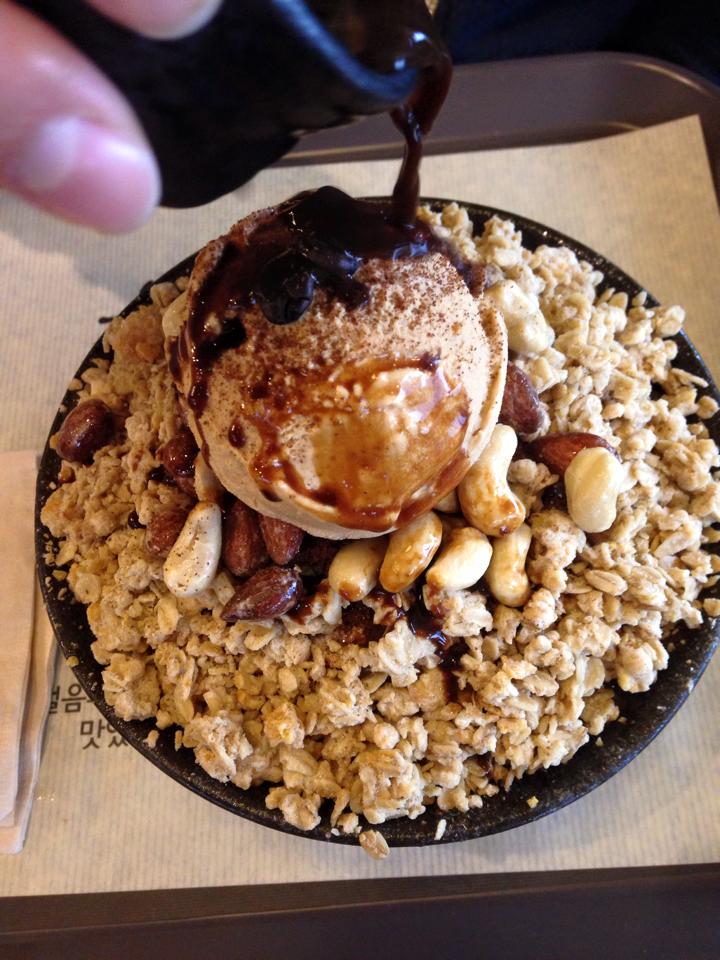
5. The Food
Before coming to Korea, I had very little experience with its food. Luckily for my husband and I, we ended up in the best city you could go to for amazing Korean food: Jeonju. This city is known for being the food capital of the country. It is where bibimbap (a mixed rice and vegetable dish) originated from, a city that holds annual food festivals, and was chosen as a Creative Cities of Gastronomy by UNESCO in 2012. Korean food typically involves rice, vegetables, and meat. Along with a main dish, Korean food almost always includes side dishes to accompany it known as banchan which is a variety of fermented foods that you can nosh on or add to your meal. Kimchi (fermented cabbage) will usually be included in one of those side dishes. Sesame oil, kimchi, garlic, ginger, red pepper paste (gochujang), fermented bean paste (doenjang), soy sauce, salt, and pepper flakes are added to flavor the dishes. Korean food is spicy but manageable for those who enjoy foods with a medium level of heat. Some of the dishes can be extremely spicy, but most are not too unbearable. I never thought that I would enjoy Korean food as much as I do, and I don’t really know anyone who dislikes it. It is definitely one of my top three foods for it’s spice, taste, variety, and presentation.
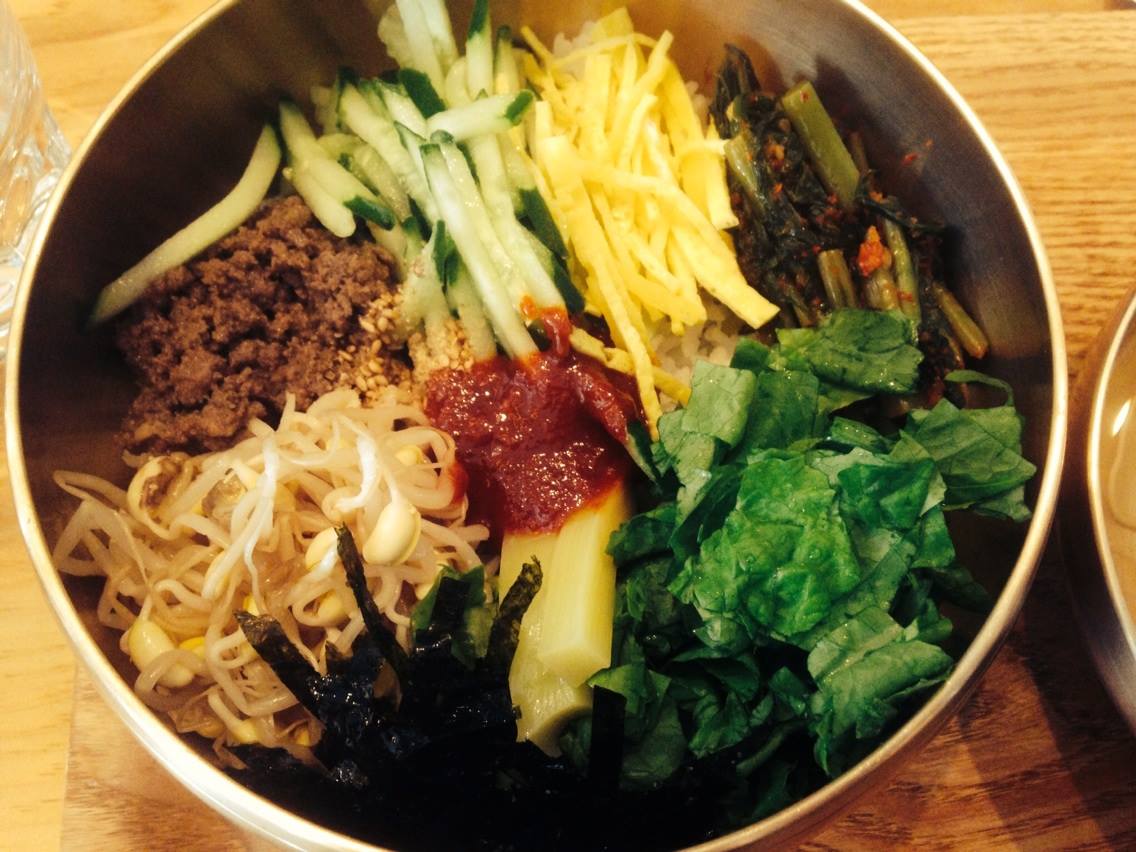
6. The Konglish
Konglish is a word to describe how Koreans’ take a romanized english word, and try to write it using Hangul (The Korean alphabet) in order to be able to write or say it in Korean. Since the Korean alphabet does not possess all of the Romanized Alphabet’s consonants and Hangul does not (as far as I know) blend two consonants together, the new Konglish word can look and sound strikingly different. Usually, one or two extra syllables are present, and vowels are added to fill in the spaces between consonants. Consonants with an ‘R’ sound make more of an ‘L’ sound, the ‘Z’ sound becomes a ‘J’ sound, “V” becomes “B”, and ‘F’ sounds more like a ‘P’. So, words like “Pinishey!” mean “Finished!”, “Joo” means “Zoo”, and my own name “Rachel” becomes “Layeechel”.
Anywhere in Korea, there are street vendors selling clothing items such as hats or t-shirts which are bound to have an example of ‘Konglish’ written in English. Also, there are constant typos and grammatical errors printed on merchandise it actually blows my mind that nobody noticed them before production. Anyways, at the end of the day it just gives us English teachers something entertaining to laugh at, and even something to purchase as a souvenir or to remind us of how much we are needed and that we do indeed have a purpose here.

7. The Coffee Shops
Coffee shops in Korea, are literally EVERYWHERE. Look no more because if you are walking on a street in a fairly large city of Korea, there are bound to be at least 3 coffee shops on your street to choose from. Ediya, Paris Baguette, Tom N Tom’s, A Twosome Place, Starbucks, and all of the smaller guys speckle the streets in mass quantities. It is wonderful for us coffee lovers who are constantly looking to satisfy that Java craving; but, alas these many, many shops usually don’t open their doors until 10:00 a.m……..10:00 A.M.!
When we first arrived in Korea, coffee was one of the first things that we sought out on morning number one. We found many coffee shops, yet none were open and it had to be around 8:00 am. It was very confusing for us as we are used to there always being a place open from 5 a.m. onwards. Of course, some coffee shops in Korea will stay open until 12:00 a.m., so I suppose that is the tradeoff.
Coffee here is also seen differently from a Korean mind to a Western mind. Back home, we see our coffee as something that ‘starts our day’, gives us energy, and is almost a necessity to consume at least one mug a morning. Whereas in Korea, coffee is something you go out to a nice shop to have for a date or to meet a friend, and the coffee is often weak sweet and seen as a treat. Of course, we see it that way too, but back home caters to both the cheap fuel coffee drinkers, as well as the ‘spend 3 hours at a starbucks to chat with a friend and enjoy the ambience coffee drinkers.’ Plus, I don’t think I have EVER seen a Korean walking around with a take-out coffee, it is just not done!
Overall, I love the mass amounts of coffee shops in Korea. Even though the coffee is quite weak for my taste, and it is more about the ‘atmosphere’ of the cafe rather than the quality of coffee that’s in your cup, they are still very nice to frequent. You can spend hours in a cafe, and no one will bother you. Some can be up to three levels and so there is always plenty of seating to choose from, and usually an options that gives you peace, quiet, and privacy. I love that some cafes even have blankets for those cold winter days which is an addition that I have yet to see in cafes back home. Korea has it’s head on right about it’s latest coffee craze, and I am excited to see how that too will evolve!
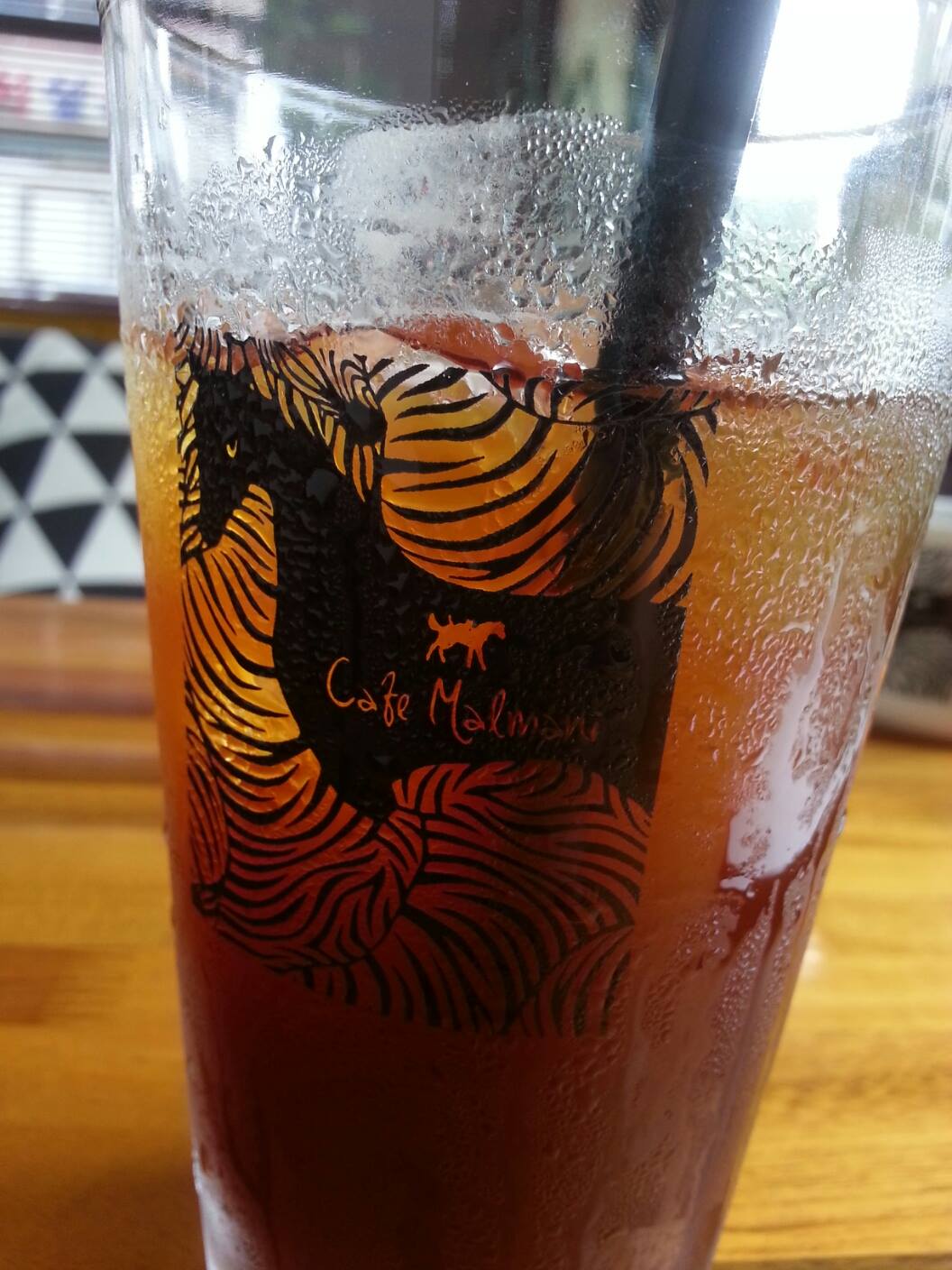
8. The Drinking Culture
Koreans love to drink. If any country has a drinking culture, Korea is one of those top countries. According to Euromonitor statistics, Korean’s consume more spirits than any other country in the world, this includes Russia. In fact, Koreans consume double what Russians do in an average week at roughly 14 shots per. person Often the drinks of choice for a night out are Soju (distilled liquor like a light vodka) and Maekju (Korean beer). There are also additional drinks only unique to Korea such as makgeolli, which is a rice based drink with a creamy and carbonated taste, as well as dongdongju which is seen in the picture below. Drinking always coincides with food and certain snacks are even said to be good paired with beer. Lastly, drinking is very social in Korea. It is how you bond with your employer, co-workers, and friends, so if you are ever invited for food, chances are you will be consuming more than just BBQ.

9. The Ease of Transportation
I love Korea’s public transportation! The buses are cheap, efficient, and frequent. The KTX is an ‘Earth Rocket’ travelling up to 350 km/hr. Seoul’s subway system is enormous, but amazing and easy to navigate despite it’s vastness. Back home in Canada, we have two intercity bus companies to choose from and both are expensive and infrequent by comparison to Korea’s. I didn’t even know what it was like to travel between cities on a train either until coming here.
A bus to Seoul from Jeonju is about a 3 hour ride and can cost as little as 12,000-26,000 won ($14.00-$30.00 CAD) and buses depart every 15 minutes. Back home, a bus ride for that length of time can cost more like $35.00 -$70.00 CAD and run about 10 times a day.
Even a taxi ride in Korea is cheap. I have never paid more than 10,000 won for a cab ride here in my city. If I pay 10,000 won, that’s because I took a taxi across the whole city. By comparison, the same taxi ride would probably cost me triple the amount, No thank you!

The above listed items are only a fraction of the things that I love about Korea. The list DOES go on but i don’t have the patience to write about each single item. Here are more of the things that just float my boat in Korea:
10. Noribangs – Karaoke rooms that you hire with a group for a certain period of time
11. Jjimjilbangs – bath houses where you walk around butt naked, soak in all of the various hot pools, get a body scrub or massage, and even a place to sleep for the night (clothed of course!). Many of the larger jjimjilbangs are equipped with cafes, DVD rooms, noribangs, and quiet places to lay and crack open a book.
12. Animal cafes such as dog, racoon, cat, snake, or even sheep cafes
13. Watching live sports games such as soccer or baseball
14. Grabbing a mart beer and drinking it outside on plastic chairs
15. Makgeolli houses – Jeonju is the place to experience this. Pay for the makgeolli, don’t pay for the food. Try the pork and Kimchi, amazing chicken soup, gingko nuts, and even live octopus!
16. Cute cartoons on every product
17. Bowing when you greet someone or are greeted (even toddlers will do it!)
18. the formalities of the drinking culture (such as accepting and serving drinks with two hands)
19. Ajummas and ajusshis walking on the park paths, swinging their arms and sporting gigantic visors and track clothes
20. Photo booths where you pay a small price to take picture with friends, you can edit them in bizarre ways (expand your eyes, add lipstick, write text, and add random clip art), then have them printed on stickers in various sizes
21. The efficiency of restaurants – all of the servers are there to assist you, there is no beating around the bush discussion from your servers about the soup of the day or sneaky ways for them to up sell you, and they don’t bother you unless you need them to assist you. Plus, your food comes in under 10 minutes for most Korean restaurants, oh yeah!
22. The way Koreans dress – Koreans dress very well. Everyone looks put together. Clothes are never ripped, torn, or worn unless it is a part of the style. Hems are never dragging, and the butts of pants are never sagging. It’s visually very appealing!
23. The contrasts of Korea – You will see business men dressed to the nines, looking sharp, and professional by day, but by night the very same men are drinking outside of a 7-eleven or CU with their ties loose or off, they are laughing hysterically while patting each others’ backs…. and they are drinking their faces off. Also, Korea developed quickly, and so it is common to see a brand new high rise building built alongside a plot of farm land….in the middle of a city! There are many more contrasts, but I think they are deserving of their own blog post!
24. Same-same couples – It is no secret that Korea’s culture revolves a lot around couples. Heck, even Christmas is considered a ‘couples’ holiday, so it is even more depressing for those singles out there than on Valentine’s Day. Of course, simply holding hands and going on dates is not quite enough to show how ‘together’ you are; try wearing the exact same outfits from head to toe (right down to your underwear). Yes, many couples in Korea walk around rocking identical clothes. Sometimes there are slight differences in the bottoms such as a skirt for the woman and pants for the man, but often they wear the same things. It’s always fun to find a coffee shop with a big window facing a sidewalk with high walking traffic, and to spot all of the Same-same couples walking proudly by.
I hope this list has helped you get to know Korea a little bit more, or has helped you reminisce about your time spent in this wonderful country. What do you love about Korea? Is there anything that I missed? Please leave a comment and let’s discuss!

